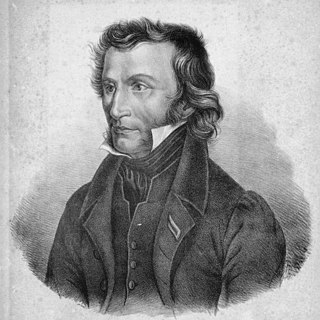Italian violinist and composer (1782–1840) From Wikipedia, the free encyclopedia
Niccolò Paganini (27 October 1782 – 27 May 1840) was an Italian composer and violin player. He is believed to be one of the greatest violinists who ever lived. He is known for 24 Caprices for Solo Violin and his La Campanella.

Paganini was born October 27, 1782 in Genoa (in modern Italy). He started the violin at age seven and took private lessons from local violinists. Paganini repeatedly outperformed his teachers such that he always had to search for new ones. He would pick up the guitar, but rarely played the guitar in public. He would start giving concerts around Italy around 1800. For many years, Paganini performed primarily in regions surrounding his hometown.
In 1813, he performed at the La Scala in Milan and gained more attention beyond local regions. He receives Order of the Golden Spur from Pope Leo VII in 1827. Between 1828 and 1831 he toured cities in present-day Germany, Poland and Czech Republic and many other large cities across Europe. This tour spread his fame beyond Italy.
Paganini was the perfect virtuoso during his time although many other violinists slowly approach and some appear to be as virtuosic as him too. He was said to be a show off during his time and many wanted to challenge his violin skills. Paganini once broke all of the strings on his violin except the G-string and played a piece just on one string to show how good he was. He intonated the violin in a different way to sound different. He was the master of violin technique and invented many new techniques such as ricochet bowing, flying staccato, and left hand pizzicato.
He met and became friends with Gioachino Rossini and Hector Berlioz. Paganini was also good friends with Franz Liszt, a similarly magnificent virtuoso. Liszt admired Paganini. In his teenage years he watched Paganini playing, and determined to be a virtuoso as Paganini in piano.
Despite his success, Paganini was frequently sick and the concert tours did not help his health. In 1834, he gave up his concert tours. He would later be employed by Marie Louise, Duchess of Parma, former Empress of the French and be in charge of the court orchestra. He tried to open a Casino in Paris, but failed. He died from internal hemorrhaging in 1840 in Nice, France.
Paganini played violins by Giuseppe Guarneri. One was called Il Cannone Guarnerius ("The Cannon of Guarnieri"). Other violins and instruments connected to him include Stradivari. They include the Paganini-Desaint 1680 Stradivari, the Le Brun 1712 Stradivari, the Hubay 1726 Stradivari, the Mendelssohn 1731 Stradivari violas and the Ladenburg 1736 Stradivari cellos. Other Italian instrument names connected to him are Amati, Goffriller and Bertolotti.
He primarily wrote for violin which he then performed. His most famous work is 24 Caprices for Solo Violin, Op. 1. They are études dealing with different violin skills. Other notable works by Paganini include Violin Concertos No. 1 & 2, Moses Fantasy, Centone di Sonate, Vol. 1, Le Streghe, Op. 8, Caprice d’Adieu, Op. 68, Ghiribizzi, Variations on ‘God Save the King’, Op. 9 and Moto Perpetuo.
Seamless Wikipedia browsing. On steroids.
Every time you click a link to Wikipedia, Wiktionary or Wikiquote in your browser's search results, it will show the modern Wikiwand interface.
Wikiwand extension is a five stars, simple, with minimum permission required to keep your browsing private, safe and transparent.